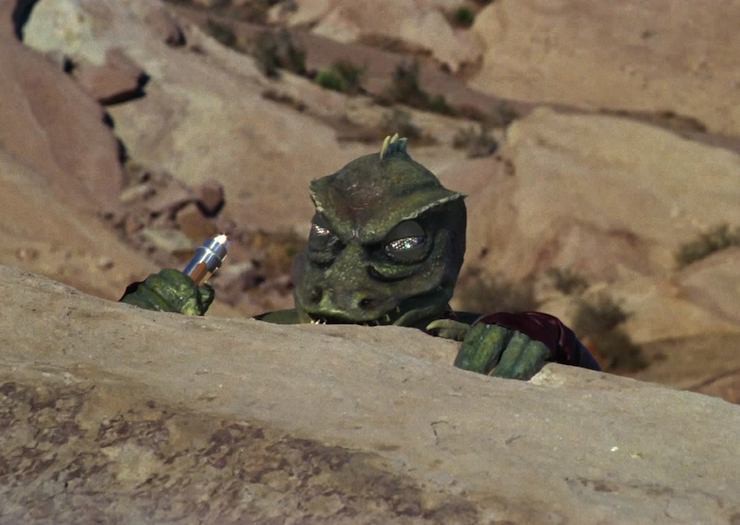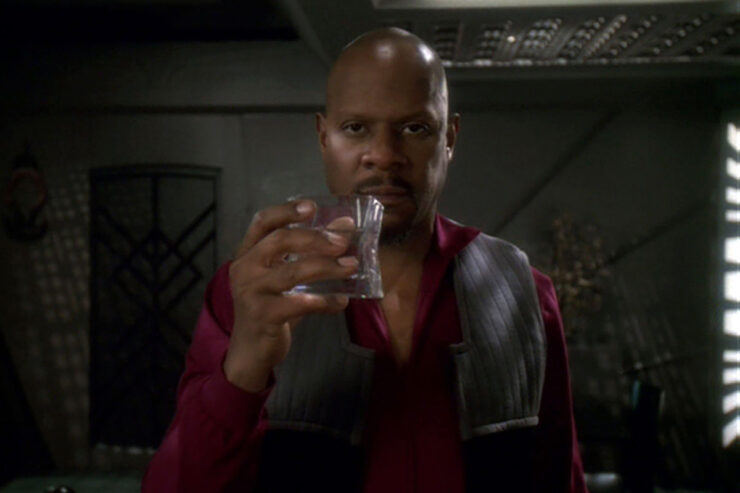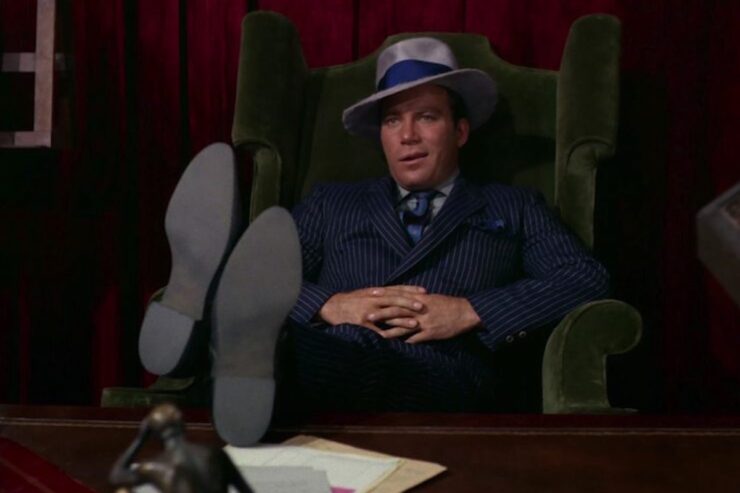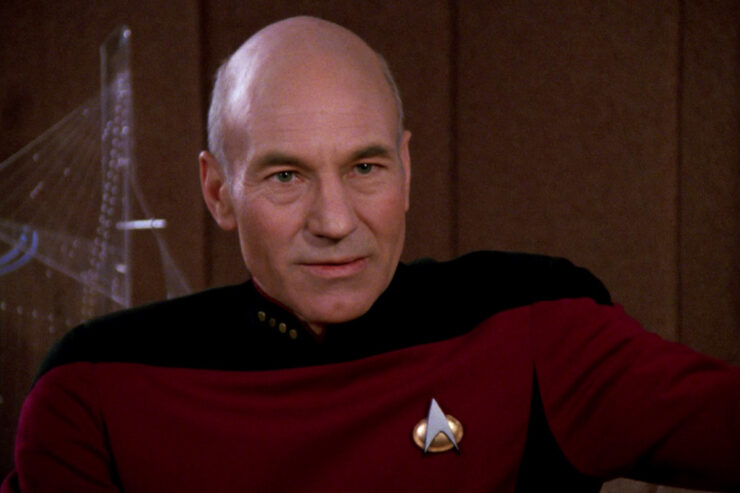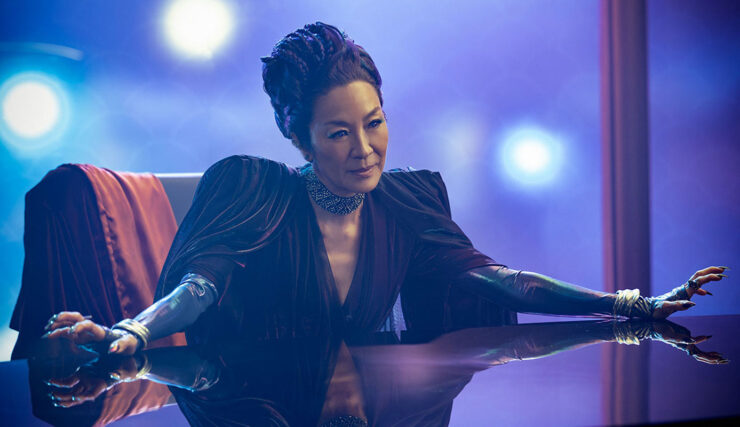“Arena”
Written by Fredric Brown and Gene L. Coon
Directed by Joseph Pevney
Season 1, Episodes 19
Production episode 6149-19
Original air date: January 19, 1967
Stardate: 3045.6
Captain’s log. Kirk, Spock, McCoy, and the Enterprise‘s best tactical specialists are beaming down to the base on Cestus III—an isolated colony, and one commanded by Commodore Travers. Kirk and McCoy are looking forward to seeing Travers’s chef as much as they are the commodore himself.
When they materialize on the surface, however, they find a smoking ruin where the base should be. Kirk immediately puts the Enterprise on red alert. The base was obviously destroyed days ago, so the messages they received from Travers were faked. Spock takes tricorder readings, while Kirk sends Lang and Kelowitz to search for survivors. O’Herlihy sticks with Kirk, Spock, and McCoy, and they find one survivor who’s got bad radiation burns and internal injuries. Spock also detects non-human life nearby. O’Herlihy investigates and is vaporized by some kind of disruptor mortar.
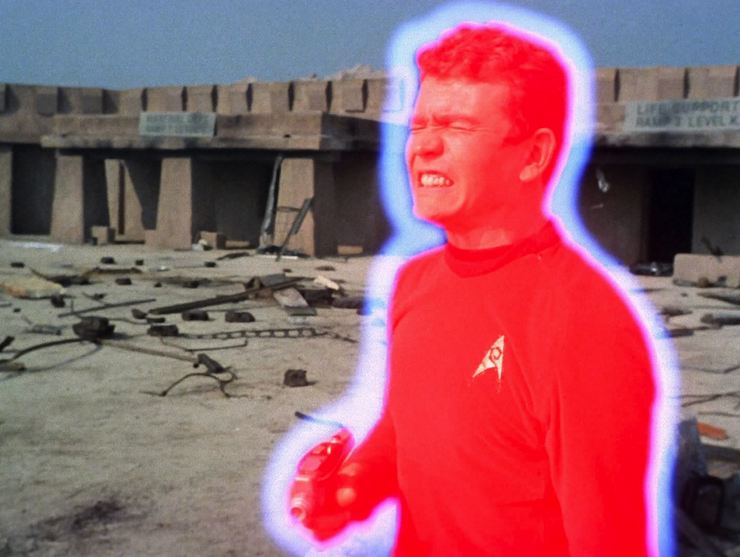
Even as the landing party comes under fire, so too does the Enterprise. Sulu has to defend the ship, so he can’t beam the party back. Kirk orders Sulu to not concern himself with the landing party until the ship is safe. Kirk, Spock, McCoy, Lang, and Kelowitz take cover in the ruins of the base, while in orbit Sulu engages the enemy ship, which has not identified itself, nor does it match any known configuration.
Sulu’s forced to leave orbit. Kirk goes to the armory and fetches a grenade launcher. Kelowitz gives Kirk a bearing as the most likely path they’d take (Lang at this point has also been killed). Kirk fires, and the shelling of the party stops. The enemy beam back to their ship and head out of orbit. Sulu’s able to beam the landing party up, now, and he does so, beaming down a medical team on Kirk’s order to search for more survivors.
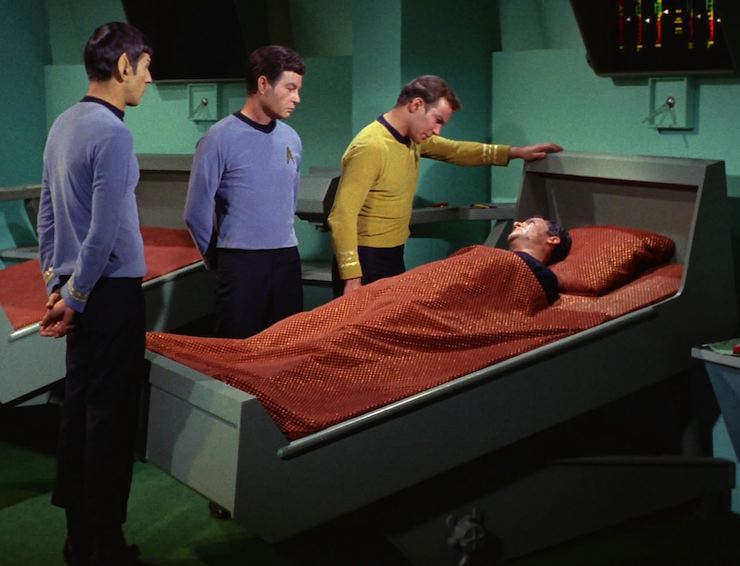
The Enterprise pursues the other ship. Kirk debriefs the survivor in sickbay. The aliens attacked with no warning, no communication, and then set a trap for the Enterprise, the only protection in the area. Kirk is convinced that this is a prelude to an invasion and so he orders Sulu to overtake the enemy vessel. They are entering an unexplored region of space.
Each time they increase speed to overtake the enemy ship, they increase speed as well. They go to warp seven, which is a speed they can’t maintain for long—and then warp eight, which is even more dangerous. But they start to close in as they near a solar system.
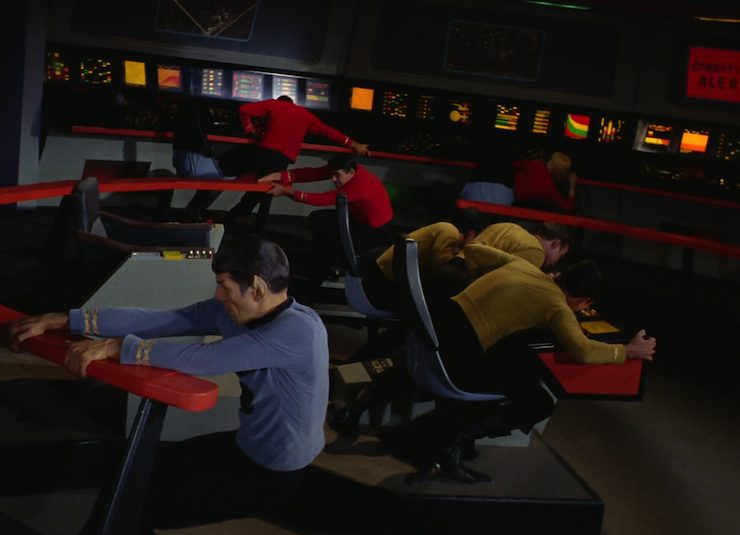
Uhura reports that someone in that solar system is scanning the Enterprise. Sulu then reports that the alien ship is slowing down to a dead stop—and then when the Enterprise moves in, they are also brought to a dead stop. All propulsion and weapons systems are inoperative—no damage, but no power, either. Life support is working fine, at least, and Spock reports that they’re being held in place by some unseen force.
They are then contacted by the Metrons, who communicate via a psychedelic light show on the viewscreen. They find the confrontation that was about to ensue to be violent and icky, and so they will resolve it in a manner most suited to their limited mentalities.
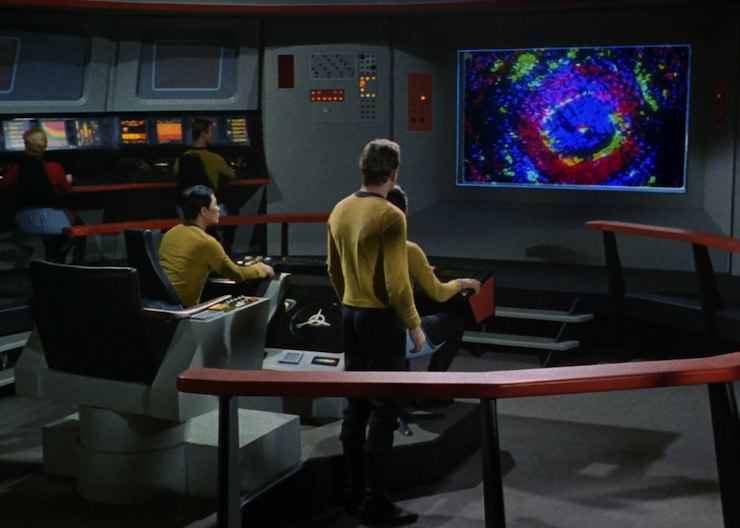
They have prepared a planet for Kirk and the Gorn captain (which is the first time the enemy has been identified by name) to battle against each other in individual combat. Elements will be provided for them to fashion weapons, and they’re equipped with translators that will enable them to talk to each other and record the combat.
While Kirk is faster than the reptilian Gorn, the Gorn is far stronger. Kirk records the equivalent of a log entry on the translator, which the Gorn listens to. The Metrons promised material to fashion weapons, and so both seek out such material. The Gorn works on a tripwire, while Kirk finds a mess of diamond shards. Kirk tries dropping a really big rock from high up onto the Gorn’s head, which knocks the Gorn down, but by the time Kirk makes it back down the outcropping he dropped it from, the Gorn is getting up. So Kirk runs away, right to the tripwire, which drops a bunch of rocks right on him. The Gorn has also fashioned a knife from a piece of rock, and he attacks Kirk with it. Only Kirk’s greater speed saves him—even limping, he’s faster than the Gorn and manages to stay ahead.
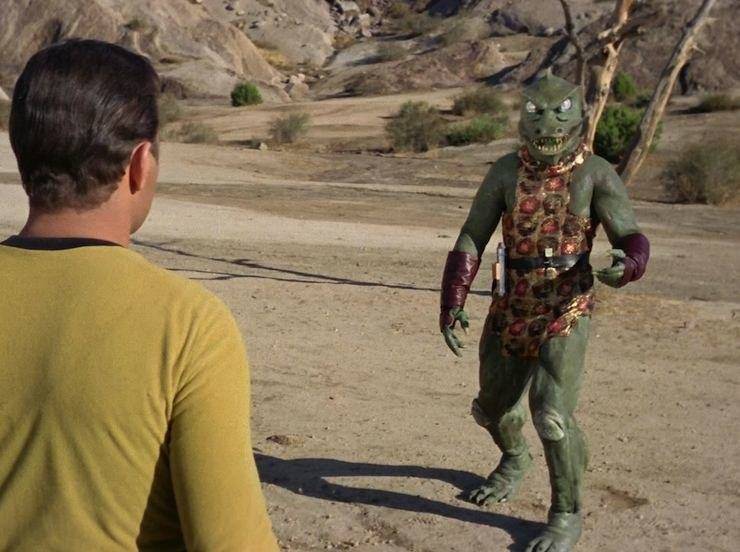
On the Enterprise, Scotty has tried every trick in the book to fix the ship, to no avail. Spock tries contacting the Metrons to parley. The Metrons magnanimously decide to let the crew see their captain’s final moments.
The Gorn talks to Kirk, requesting that Kirk stay put for a merciful death, as he’s weary of the chase. In addition, the Gorn reveals that Cestus III is within Gorn space, and they viewed the establishment of a base there as the first wave of an invasion. The Gorn were only protecting their own.
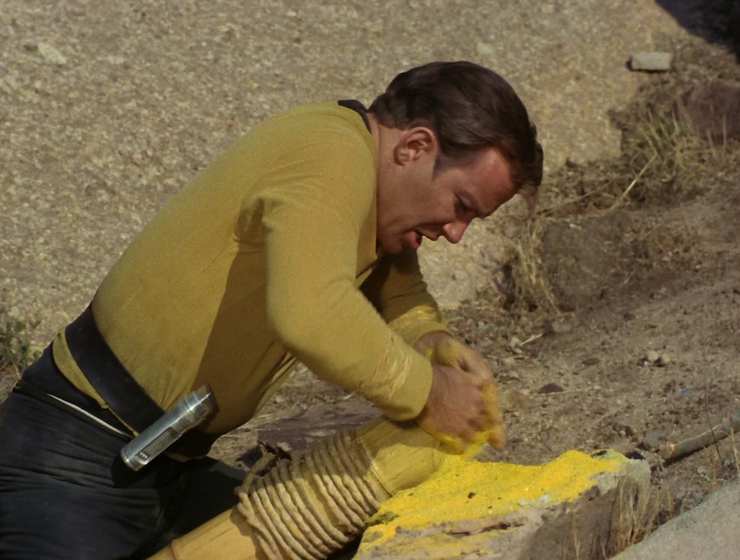
Kirk finds a deposit of sulfur, and then later finds potassium nitrate. He then gathers a hollow wooden tube and a bit of stringy stem. He puts the potassium nitrate and the sulfur in the tube, and uses the diamonds as projectiles. He finds some coal, adds that, and then mixes it all up after crushing the coal. He uses the stringy stem as a fuse, lights it with a piece of cloth and fires the diamonds right at the Gorn’s chest.
The Gorn is at Kirk’s mercy and he is about to stab him in the chest with his own knife—but then he stops himself. If the Gorn saw the establishment of the outpost as an act of war, then he was only defending his territory.
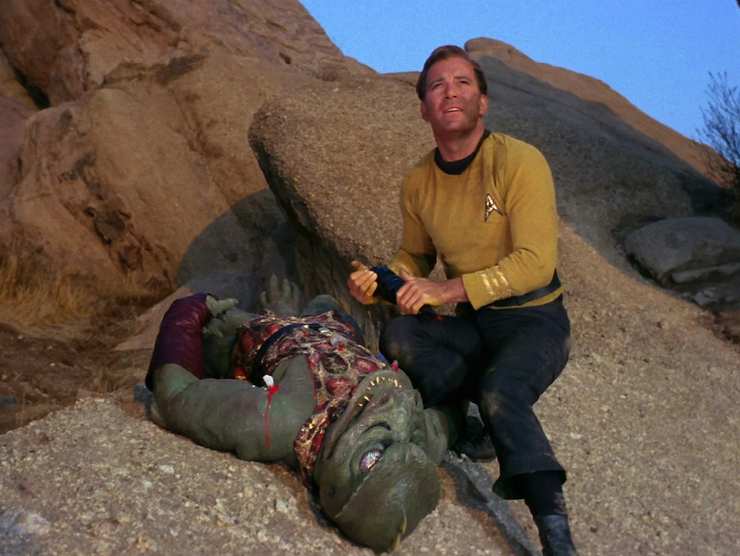
That act of mercy saves Kirk, as one of the Metrons explains. He sends the Gorn back to his ship, and offers to destroy them, but Kirk says no, they can talk and work out an agreement.
Kirk reappears on the bridge. Sulu is shocked to see that the Enterprise is somehow halfway across the galaxy from where they’re supposed to be. They set course back to Cestus III and, with luck, a proper first contact without all the violence…

Can’t we just reverse the polarity? The Metrons are kind enough to leave all the material necessary to make gunpowder.
Fascinating. Spock tries to point out to Kirk that there could be any number of reasons why the Gorn massacred the Cestus III colony, but Kirk won’t hear of it, insisting that there is only one possible explanation. And then when the Gorn captain tells him that the establishment of the colony on that planet was viewed as an invasion, he realizes belatedly that he probably should’ve listened to his first officer.
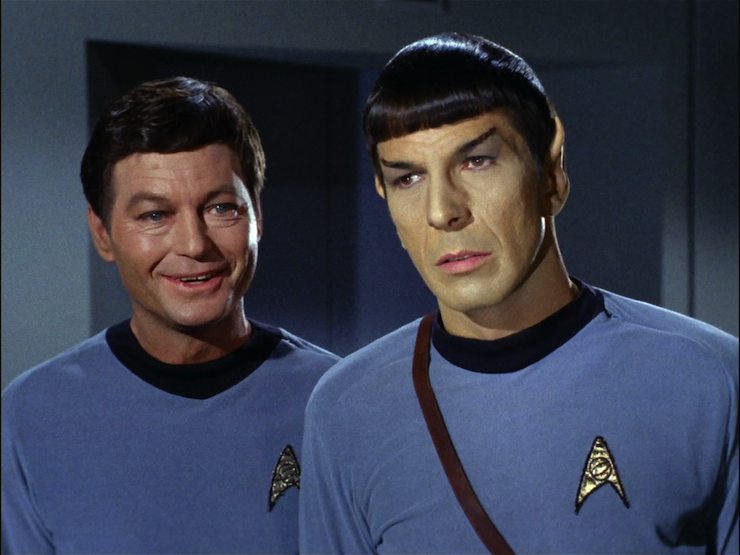
I’m a doctor not an escalator. When McCoy waxes rhapsodic about Travers’s hospitality, in particular his chef, Spock dismissively says that the doctor is a sensualist, to which McCoy replies, “You bet your pointed ears, I am.”
Ahead warp one, aye. As implied in “The Man Trap,” when Kirk assigned Sulu to put the ship at general quarters and search for the salt vampire, Sulu is considered third in command of the ship. This is the first of two occasions in the first season where Kirk will leave Sulu in command during a combat mission, the next being “Errand of Mercy.” Spock also reminds Kirk that Sulu is an experienced combat officer, which is pretty impressive for a guy who was the ship’s physicist not that long ago…
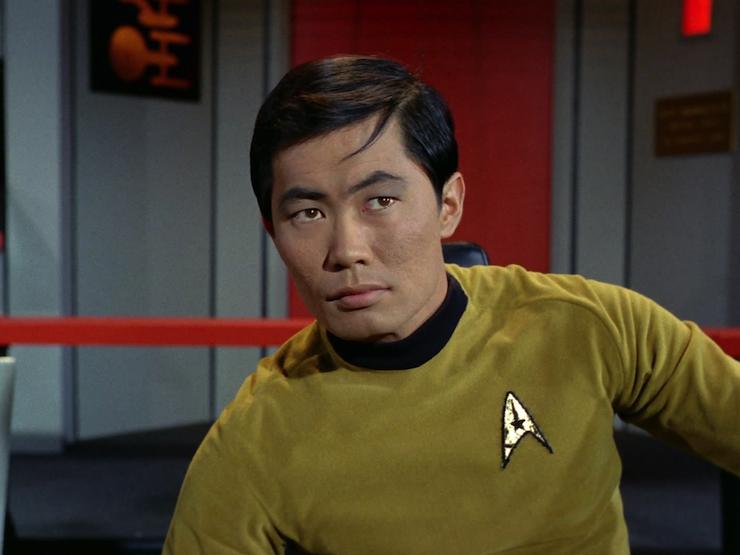
I cannot change the laws of physics! Scotty looks pained when Kirk asks for higher warp speeds, but says nothing. When Spock makes suggestions on how to bypass the Metrons’ iron grip, Scotty says he already tried everything Spock suggested.
Hailing frequencies open. When Kirk disappears from the bridge, Uhura lets out a huge scream. Until Star Trek V‘s fan dance, it was the single most undignified moment the character had.
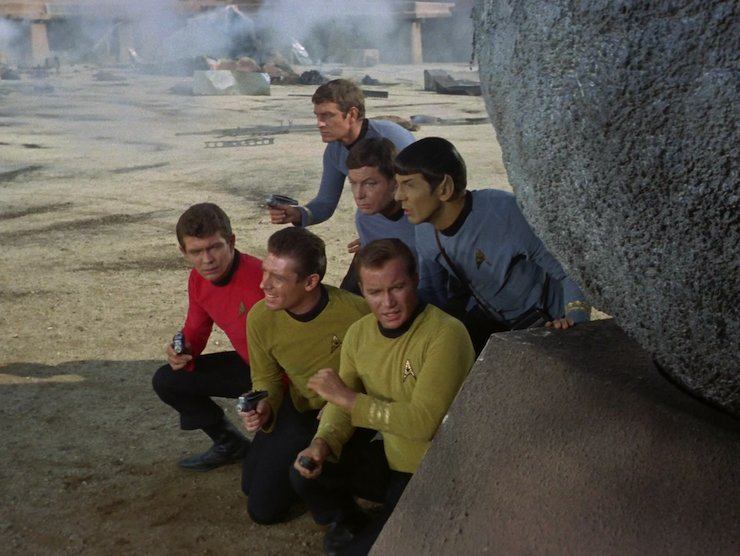
Go put on a red shirt. Two of the three tactical experts—who are, in a sop to NBC’s recent adaptation of full color broadcasting, wearing each of the three possible colored shirts—are killed. Lang doesn’t even get to be killed on camera, the poor bastard.
Channel open. “We’re a most promising species, Mr. Spock, as predators go—did you know that?”
“I’ve frequently had my doubts.”
Kirk giving the moral of the story and Spock being a doubting Thomas.
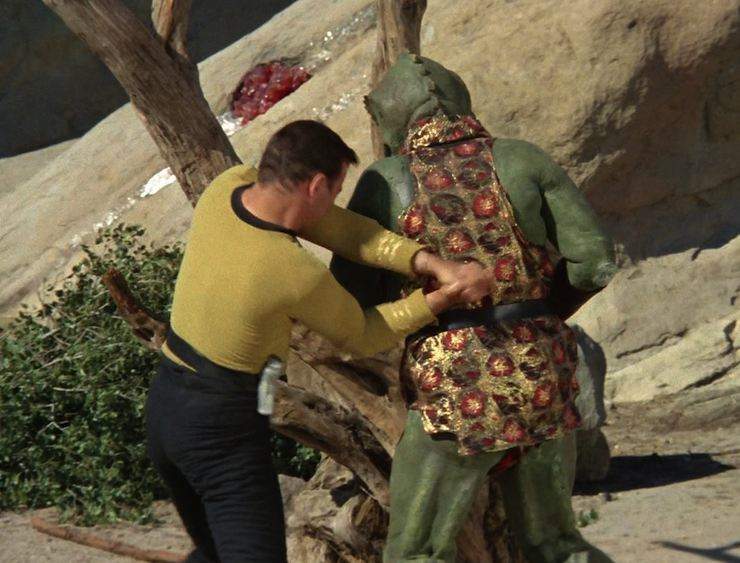
Welcome aboard. The Gorn captain was played by four different people: William Blackburn played him in head-shot closeups, Bobby Clark and Gary Combs both played him in longer shots, and Ted Cassidy provided the voice. Clark later “reprised” the role in a promo with William Shatner for the Star Trek videogame released in 2013.
The Metron was played by two people: Carole Shelyne physically played the role, but the Metron’s voice was provided by an uncredited Vic Perrin, probably best known as the voice of the classic opening to The Outer Limits.
Jerry Ayres, Grant Woods, and James Farley play the Enterprise tactical experts in the landing party, Tom Troupe plays the Cestus III survivor, Sean Kenney (the injured Pike in “The Menagerie“) makes the first of two appearances as DePaul, the latest member of the navigator derby, and we have recurring regulars DeForest Kelley, George Takei, James Doohan, and Nichelle Nichols.
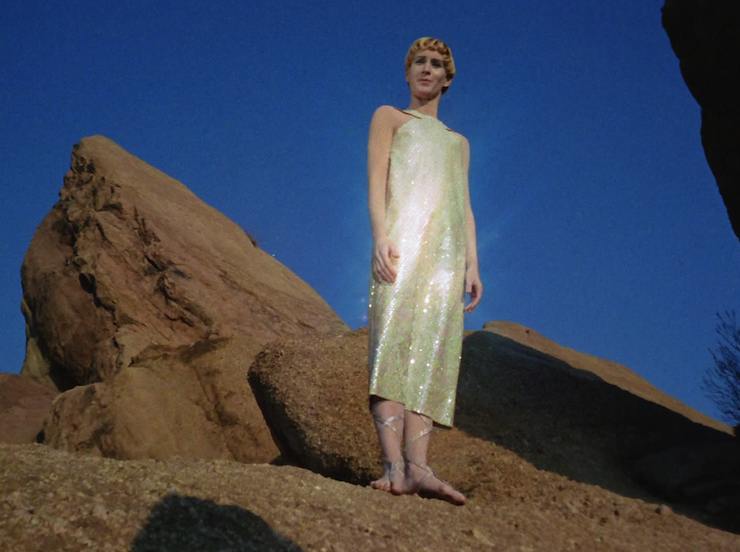
Trivial matters: This is the first episode scripted by Gene L. Coon, who was the show-runner for the back end of season 1 and all of season 2, and also the first directed by Joseph Pevney. Pevney was brought in by Coon because of his reputation for filming fast, and he got this episode done in six days instead of the usual seven (which earned him a bonus). Pevney went on to direct thirteen more episodes of the original series (including the two episodes that tend to hit the top of most folks’ best-of lists, “The City on the Edge of Forever” and “The Trouble with Tribbles“).
Coon’s original script had the Metron admitting that their plan was to destroy the winner of the conflict, as that side would pose the greatest threat to the Metrons. But Kirk’s showing mercy changed their minds. That bit was in James Blish’s adaptation in Star Trek 2.
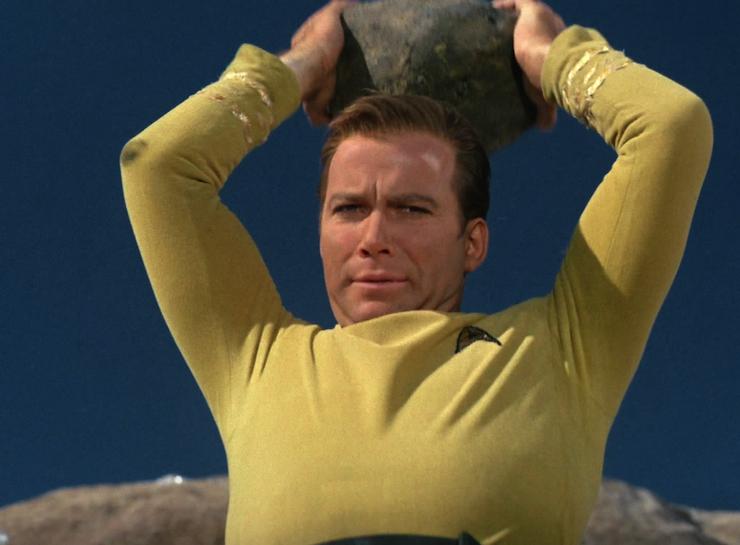
Fredric Brown’s story credit was due to Coon’s script being unintentionally similar to a short story by Brown with the same title that was published in Astounding Science Fiction in 1944. After the similarities were pointed out to Coon, he bought the rights to (retroactively) adapt the story.
Of all the Trek episodes that did location filming at Vasquez Rocks, this is probably the most famous. The movies Bill and Ted’s Bogus Journey, Jay and Silent Bob Strike Back, Free Enterprise, and Paul all have homages to the use of the rocks in this episode.
This episode is the first one that mentions the Federation by name. All episodes prior to this have implied that the Enterprise is purely an Earth ship (despite having Spock on board).
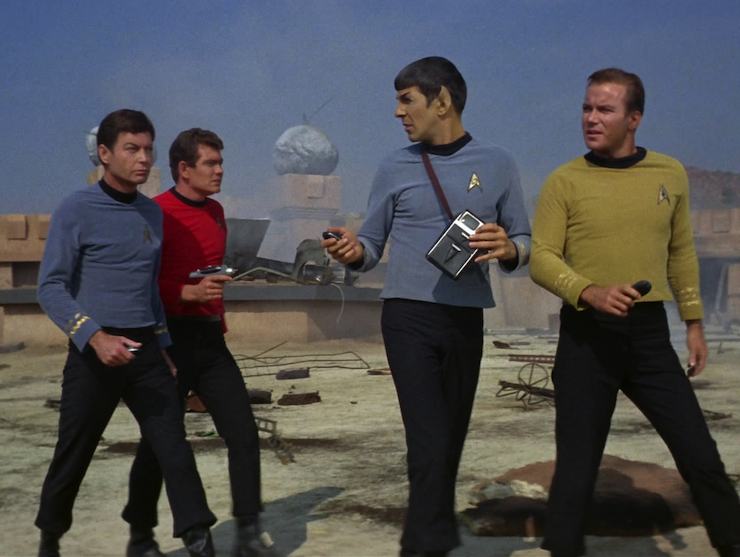
Cestus III will have become a Federation colony by the 24th century, according to DS9‘s “Family Business,” where it’s established that Kasidy Yates comes from there. Your humble rewatcher established a bunch of stuff regarding Cestus III in the novels A Time for War, a Time for Peace, Articles of the Federation, Q & A, and A Singular Destiny, all of which have characters from that colony.
The Gorn won’t be seen again onscreen in the mainline timeline, though the Gorn of the Mirror Universe will be seen (rendered with CGI rather than a guy in a suit) in the Enterprise episode “In a Mirror, Darkly.” They are used extensively in the tie-in fiction, most notably The Gorn Crisis by Kevin J. Anderson, Rebecca Moesta, & Igor Kordey, which established a culture and society for the Gorn that has informed all subsequent appearances of the Gorn. In addition the Gorn have been part of the Typhon Pact that has served as an antagonist to the Federation in recent 24th-century novels.
One of the onscreen mentions of the Gorn is in DS9‘s “Trials and Tribble-ations,” when Sisko tells Dax that he’d love to ask Kirk about facing the Gorn on Cestus III.

To this day, William Shatner suffers from tinnitus due to a special-effects explosion during this episode.
An episode of Mythbusters attempted to re-create Kirk’s makeshift cannon, and determined that it couldn’t be done, with the caveat that the properties of the wood on an alien planet might be different…
To boldly go. “You are still half savage.” This episode is a classic example of what made Star Trek unique in the late 1960s. In an era where World War II wasn’t that long ago, in an era when the Cold War was at its height, the notion of an enemy out to destroy our way of life was on everyone’s minds, whether it was Germany, Japan, and Italy two decades previous or the Soviet Union and their allies in the present.
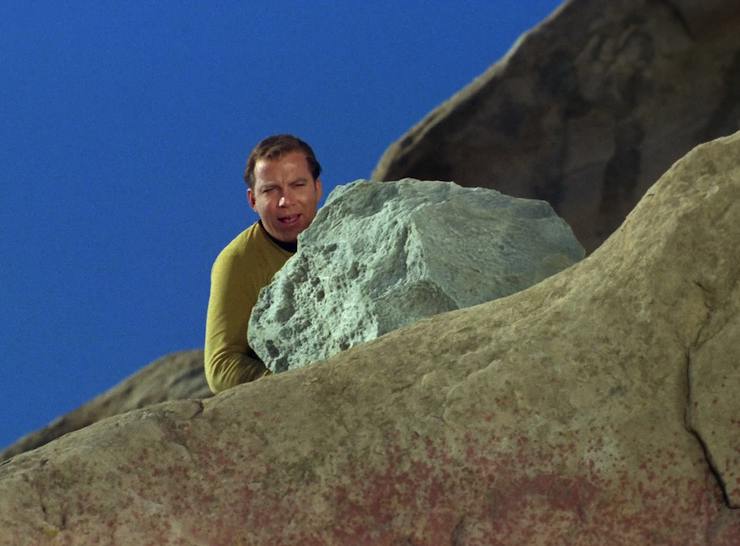
Not that the notion has gone away five decades later, but the popular culture of the time tended toward a black and white view. Any other adventure show would have had the same story beats for the first three acts, but a much different fourth act, in which our hero would have struck the fatal blow against the evil bad guy. And we know he’s evil because he hisses and snarls and looks like a lizard and he ordered the deaths of all those people.
But Star Trek didn’t do that. Star Trek had the Gorn captain have the same attitude toward the establishment of a colony on Cestus III that Kirk had returning from that planet after the Gorn attacked it: it has to be an invasion, there’s no other possible explanation. And because both sides reacted with violence rather than talking, more people died. It takes an act of compassion on Kirk’s part to stop the violence and get the two sides talking to each other.
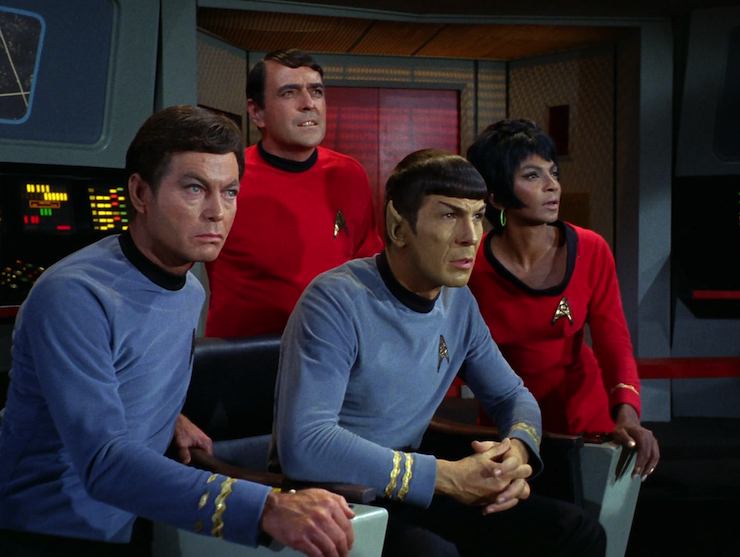
We never do see the results of that talking, though the fact that Cestus III is a Federation planet in the 24th century indicates that some kind of agreement was come to.
But the point is that the talking was the end result. This sort of story with that kind of twist is commonplace now, but Star Trek was one of the first to do it—and unlike other genre shows that pulled this kind of switch like The Twilight Zone and The Outer Limits, the twist wasn’t there for the sake of pulling a fast one on the viewer or to reveal a more devastating unexpected truth. No, the twist here comes from a place of compassion, of enlightenment, of making a mistake and realizing it.
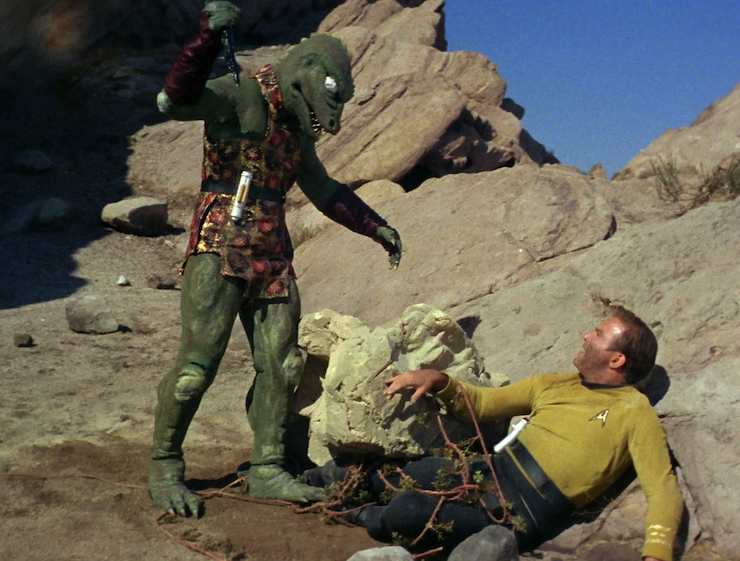
The episode isn’t perfect. Neither of the devices used to convey exposition to the viewer—Kirk narrating into the Metron-provided translator/communicator, Spock explaining everything to the bridge crew as they watch—works particularly well, and slows the climactic action. But when the script allows director Joseph Pevney to just show the action, it’s superlative, a great use of the Vasquez Rocks location (both in the captain-captain fight and in the earlier scene on Cestus III when the landing party’s being shelled). But ultimately, it’s about the dangers of space and of quick judgments, and of the power of compassion and mercy. Those are all worthwhile as storytelling devices and as morals. Bravo.
Warp factor rating: 9
Next week: “The Alternative Factor”
Keith R.A. DeCandido is involved with two nifty Kickstarters, one for a superhero anthology called The Side of Good/The Side of Evil (in which Keith will have a story), the other for a web series that combines 50s and 60s pulp sci-fi with a modern sensibility (think Buckeroo Banzai meets Emma Peel) starring Singularity & Co.’s Cici James called Atomic Annie (for which Keith will be putting together a short-story anthology).










